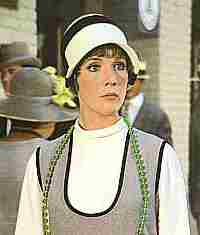 A music-hall favorite since childhood, British entertainer Julie Andrews spent the war years dodging Nazi bombs and bowing to the plaudits of her fans. Thanks to her own talents and the persistence of her performer parents, Andrews maintained her career momentum with appearances in such extravaganzas as 1947's Starlight Roof Revue. It was in the role of a 1920s flapper in Sandy Wilson's satire The Boy Friend (1953) that brought Andrews to Broadway; and few could resist the attractively angular young miss warbling such deliberately sappy lyrics as "I Could Be Happy With You/If You Could Be Happy With Me." Following a live-TV performance of High Tor, Andrews regaled American audiences in the star-making role of cockney flower girl Eliza Doolittle in the 1956 Broadway blockbuster My Fair Lady. The oft-told backstage story of this musical classic was enough to dissuade anyone from thinking that Andrews was an overnight success, as producer Moss Hart mercilessly drilled her for 48 hours to help her get her lines, songs and dialect in proper working order. In 1957, Andrews again enchanted TV audiences in the title role of Rodgers & Hammerstein's musical adaptation of Cinderella. Later, Alan Jay Lerner and Frederick Loewe — also the composers of My Fair Lady — developed the role of Guinevere in their 1960 musical Camelot with Andrews in mind, and the result was another Broadway triumph, albeit not as profitable as Fair Lady.
A music-hall favorite since childhood, British entertainer Julie Andrews spent the war years dodging Nazi bombs and bowing to the plaudits of her fans. Thanks to her own talents and the persistence of her performer parents, Andrews maintained her career momentum with appearances in such extravaganzas as 1947's Starlight Roof Revue. It was in the role of a 1920s flapper in Sandy Wilson's satire The Boy Friend (1953) that brought Andrews to Broadway; and few could resist the attractively angular young miss warbling such deliberately sappy lyrics as "I Could Be Happy With You/If You Could Be Happy With Me." Following a live-TV performance of High Tor, Andrews regaled American audiences in the star-making role of cockney flower girl Eliza Doolittle in the 1956 Broadway blockbuster My Fair Lady. The oft-told backstage story of this musical classic was enough to dissuade anyone from thinking that Andrews was an overnight success, as producer Moss Hart mercilessly drilled her for 48 hours to help her get her lines, songs and dialect in proper working order. In 1957, Andrews again enchanted TV audiences in the title role of Rodgers & Hammerstein's musical adaptation of Cinderella. Later, Alan Jay Lerner and Frederick Loewe — also the composers of My Fair Lady — developed the role of Guinevere in their 1960 musical Camelot with Andrews in mind, and the result was another Broadway triumph, albeit not as profitable as Fair Lady.
Although a proven favorite with American audiences thanks to her frequent TV variety show appearances (notably a memorable 1962 teaming with Carol Burnett), Andrews did not make a motion picture until 1964. As Mary Poppins, Andrews not only headlined one of Walt Disney's all-time biggest moneymakers, but also won an Oscar — sweet compensation for having lost the Eliza role to Audrey Hepburn for the adaptation of My Fair Lady. Andrews hoped that Mary Poppins would not type her in "goody-goody" parts, and, to that end, accepted a decidedly mature role as James Garner's love interest in The Americanization of Emily (1964). However, Andrews' next film, The Sound of Music (1965) effectively locked her into sweetness and light parts in the minds of moviegoers. On the strength of the success of Music, Andrews was signed to numerous Hollywood projects, but her stardom had peaked, and by the time she made the much-maligned Darling Lili (1970) for her husband/director Blake Edwards, she was perceived as a has-been. Her talent had not diminished, as illustrated by her '70s nightclub appearances and her weekly TV series, where she was better than ever. But Andrews was the victim of changing Hollywood tastes and mores; and, as far as producers and the public were concerned, she was sentimental, sugary, and old hat. A strong comeback in 1978's 10 confounded these naysayers, as did Andrews' portrayals of such complex characters as the truculent movie prima donna in S.O.B. (1981), the female/male/female impersonator in Victor, Victoria (1982), the frustrated multiple sclerosis victim in Duet for One (1986), and the grieving mother of an AIDS victim in Our Sons (1991), securing her reputation as an actress of unbounded versatility.
 Among the many songs that Julie Andrews has performed and recorded, there is one interesting performance of a Jolson classic, sung by Jolie many years previous, and included as a Kraft Music Hall number. From the movie Thoroughly Modern Millie, enjoy this version of:
Among the many songs that Julie Andrews has performed and recorded, there is one interesting performance of a Jolson classic, sung by Jolie many years previous, and included as a Kraft Music Hall number. From the movie Thoroughly Modern Millie, enjoy this version of: